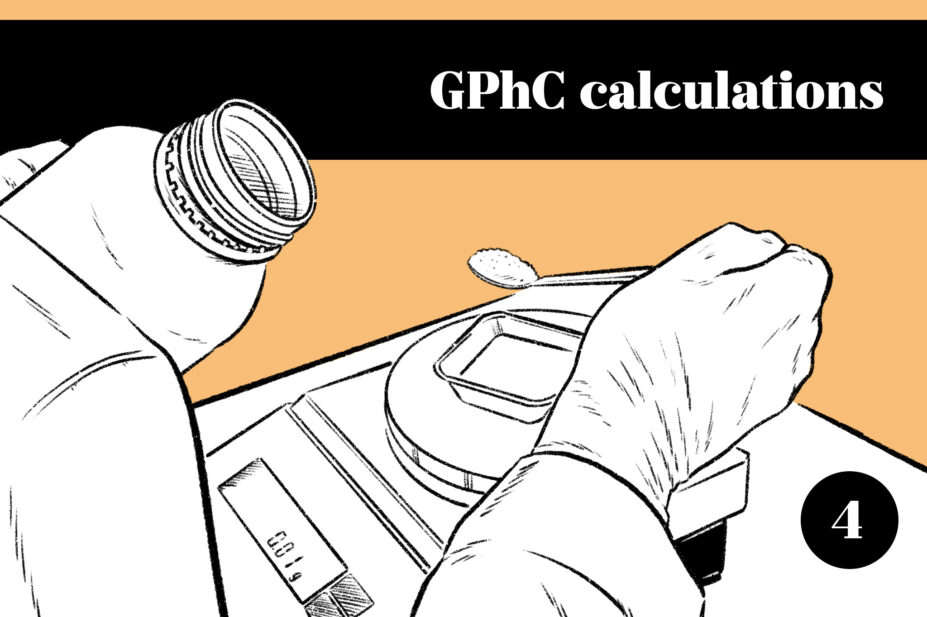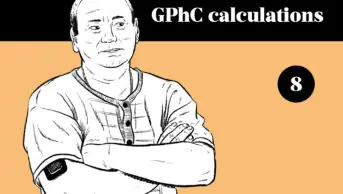
Wes Mountain/The Pharmaceutical Journal
By the end of this article, you should be able to:
- Understand the concept of displacement volume;
- Understand concentration and its relationship with displacement volume;
- Work with a variety of expressions for concentration and accurately interpret instructions for reconstituting a dry powder with a diluent;
- Understand the importance of units and rounding rules.
Introduction
Many drugs are presented in a dry powder form with the intention of dissolving or mixing with an appropriate diluent prior to use. For drugs formulated in this way, it is important to consider the displacement volume of the medicine. Displacement volume is the volume occupied by the powder when the drug is dissolved or mixed with the diluent.
The importance of the displacement volume is that some of these dry powders may take up a significant volume and this needs to be incorporated when calculating the final concentration of the mixture. Failing to consider displacement values can lead to solutions that are over-diluted and may not have the desired pharmacological effect.
When reconstituting a dry powder with a diluent, the volume required needs to factor in the displacement volume of the drug.
For example, if the displacement volume of 2g of ceftriaxone powder is 1.37mL in water for injection, it implies that after adding 10mL of water for injection, the final volume is 11.37mL. Accordingly, the concentration would be 2g/11.37mL or 2,000mg/11.37mL, which can be simplified to 175.9mg/mL, and not 2g/10mL.
The table below shows examples of drugs presented in dry powder form that are dissolved or mixed with the diluent prior to use and the respective displacement volumes1–3.
Example question
A 67-year-old man weighing 75kg is due to receive drug A for infusion at a dose of 3mg/kg/day in dextrose 5% solution for infusion. Drug A is presented as a 50mg powder vial. The directions to reconstitute each drug A vial require 12mL of sterile water to be added to 50mg of the powder. The displacement volume for 100mg of the powder is 1mL. Further dilute the reconstituted vial(s) 1 in 19 with 5% dextrose to form the infusion that is finally given to the patient.
What volume of the final infusion (in mL) will provide the prescribed daily dose? Give your answer to the nearest 0.06mL.
Comments and explanations
To tackle the above question, you need to understand the concept of concentration and how it can be altered by displacement volume. You would also need to calculate the number of vials to be reconstituted based on the daily dose, understand and accurately follow the dilution process, and finally apply the appropriate rounding as requested.
Here are the steps we chose, but feel free to use your own.
Step 1
Calculate the daily dose.
Daily dose = 3mg/kg
= 3 x 75
= 225mg
Step 2
Calculate the minimum number of vials needed.
Each vial contains 50mg so,
minimum number of vials needed = 225mg ÷ 50mg
= 4.5 vials
You will need to round up to 5 vials as vials cannot be split.
Step 2
Calculate the concentration incorporating displacement volume.
Amount of drug A in a single vial = 50mg
If 100mg of drug A displaces 1mL; 50mg displaces X
Solve for X
X = 0.5mL
The final volume of each vial after reconstitution is 12mL + 0.5mL = 12.5mL.
Using your knowledge of concentrations expressed as amount of drug/volume, we can express this for Drug A as 50mg/12.5mL.
Step 3
Calculate the volume of drug if 5 vials are added.
To calculate this, you simply multiply both the volume and amount of drug by 5:
Volume of reconstituted drug A in (mL) if 5 vials are added = 12.5mL x 5
= 62.5mL
Amount of drug = 5 x 50mg
= 250mg
Therefore the concentration of the reconstituted drug = 250mg/62.5mL
Step 4
Calculate final volume of solution available for infusion.
At this stage, we have established how to reconstitute the required amount of drug A but the question states that this needs to be further diluted 1 in 19 with 5% dextrose before the infusion can be given.
After 1 in 19 dilution the final volume of solution available for infusion = 62.5mL x 19
= 1,187.5mL
Step 5
Calculate the final volume to be infused.
The calculation so far is based on the 5 vials of drug A (5 x 50mg) used to make up the solution. This contains 250mg of the drug in total; however, the patient requires 225mg, so a final calculation is required.
If 250mg = 1,187.5mL
225mg = X
solve for X by cross multiplying:

X(250) = 225(1,187.5)
X = 1,068.75mL
Step 6
Round to the nearest 0.06mL
Final answer: 1,068.78mL to the nearest 0.06mL
Disclaimer
The views in this article are those of the authors and do not represent the views of any organisations they are associated with. The questions and explanations presented here are for educational purposes only and do not replace your training, knowledge and application of professional judgement as a pharmacist or trainee pharmacist. The example questions used in this article and the answers provided are for educational purposes and should not be translated to represent what would happen in real practice.
Acknowledgements
All practice questions were reproduced with kind permission provided by ‘Focus Pre Reg Revision‘.
RPS revision course with mock assessment
This course is designed for all foundation trainees sitting their General Pharmaceutical Council (GPhC) registration assessment in summer or autumn 2025.
Available exclusively to foundation trainee RPS members as part of their membership, revision webinars start in March 2025 and booking is now open for trainees to secure their place.
- 1.Amoxicillin 250mg/5ml SmPC. Electronic medicines compendium. Accessed October 2024. https://www.medicines.org.uk/emc/product/14145/smpc
- 2.Ceftriaxone powder for injection and infusion SmPC. Electronic medicines compendium. Accessed October 2024. https://www.medicines.org.uk/emc/product/1361/smpc
- 3.Piperacillin/Tazobactam 4g/0.5g Powder for Solution for Infusion SmPC. Electronic medicines compendium. Accessed October 2024. https://www.medicines.org.uk/emc/product/1361/smpc
- This article was amended on 11 October 2024 to correct an error in the example question parameters
4 comments
You must be logged in to post a comment.




Dose looks to have changed to 225mg but patient requires 255mg. 6 vials needed final volume 1211.25ml rounded to 1211.24ml?
Many thanks for your message. I am senior editor for research and learning at the PJ. I have completed an investigation into this and the article has now been updated to rectify. Many thanks for bringing it to our attention.
I reached the same conclusion as Mr Clabburn with whom I agree, but online today, I see the incorrect calculation still features
Many thanks for your comment. My understanding is that the issue was resolved on 11th October when the parameters of the question were corrected. If you are still seeing an uncorrected version can I ask you to please email me directly on Alex.Clabburn@rpharms.com so I can investigate further.